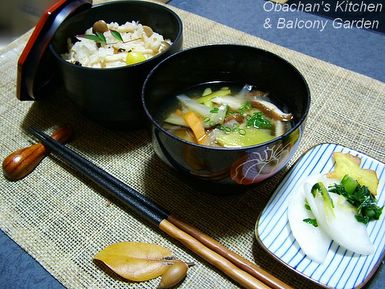Just a couple more experimental batches to follow my previous moffle post. To make these two types of moffles, I used thin mochi (rice cakes) and VERY thin ones. The dessert moffle in the first photo was made by making plain moffles with the thin rice cakes and topping them with the sweets. The savory variety in the second photo was made with the very thin rice cakes called shabu-shabu mochi, with the filling being sandwiched between them. FYI, the shabu-shabu mochi is very thinly sliced and named so because it is used for a Japanese hot-pot dish called shabu-shabu. When you eat shabu-shabu, you swish thinly sliced meat or cut vegetables in boiling dashi broth a few times and dip in dipping sauce and eat immediately. To be eaten that way, the rice cake needs to be very thin so that it softens quickly. (This shows you what it looks like when eaten in shabu-shabu.) Now, here's how I made the savory, sandwich-like moffles. It's recommended to place one edge of the rice cake on that of the other one. That way, you can prevent the filling oozing out from the gap between the two rice cakes before they become soft and stick to each other. To be honest, I wasn't too impressed with the dessert moffle above. The cheap matcha ice cream didn't have a good flavor in the first place, and the moffles tasted rather bland. Besides, the moffles turned rather soggy than soft while I was taking the photos. Maybe I should have made them with the shabu-shabu mochi with the azuki an as a filling, then topped them with azuki an and ice cream. The savory version was pretty good. :D And it looked so cute with the colors of mentaiko and shiso showing through the moffle crust, like this:  I have a couple more ideas of savory versions, hence more moffle posts to come. (Don't know how soon, though.) Oh I wish shabu-shabu mochi was not that expensive! *** WARNING!! *** To make moffles, here in Japan we use mochi (rice cake) made by pounding steamed glutinous rice. There is a softer type of rice cake made from mochiko (rice flour) -- the mochi used as daifuku skin. Now, I have never ever seen, heard or read about anyone in Japan making moffles using that softer mochi, and I DO NOT recommend anyone to do so because it may stick to the waffle maker and make a mess. Well, it may not -- but we don't know until someone actually gives it a try. ********************* P.S. Great news!! I finally managed to open the jars of my two-year-old cucumber pickles! Of course I'm not gonna eat 'em but so happy to have more space in the fridge and more empty jars in the cupboard... Yay!! :D Categories: Japanese |
Thursday, February 26, 2009
Look! More Moffles! -1-
Posted by
obachan
at
2/26/2009 10:23:00 AM
13
comments
![]()
Labels: Rice dish
Wednesday, January 28, 2009
... And Look, Moffles!!
Gosh I really want to thank the person who invented this stuff! Moffle is a word made by combining mochi (rice cakes) and waffle, and what it is is rice cakes baked in a waffle maker. I had herad a lot about it, and been curious about it. Now today, after making the waffles in the above post, I decided to go for this moffle thing, too, to satisfy my curiosity. Luckily, I didn't have to go out and buy some mochi; I had two of them from the outdoor tea ceremony event in my hometown last Sunday. In Japanese rural areas, people still keep the traditional custom of throwing rice cakes to celebrate happy occasions, and they did that at the event. (Atually in my hometown, it's becoming popular to throw things like packed sweets and instant ramen noodles in addition to mochi. Is it the same in other areas in Japan?) Anyway, I had these two rice cakes on hand: I was a bit worried that these may be too thick, and thought about microwaving them beforehand. But I thought, "Oh, what the heck," and put them on the bottom of the waffle maker and closed it. Of course, it didn't close. But as the rice cakes softened, the top iron of the waffle maker gradually came down and finally completely closed. I didn't know exactly how long I was supposed to bake and was worried about burning them, so I lifted up the top several times to check on them. First, the rice cakes were flat disks and the center looked still raw. But after I turned over the waffle maker and baked some more, they started making noise. (It was the sound of heated air inside the mochi coming out.) Then they started spreading out, filling out the iron and then -- believe it or not -- started pushing up the top! And finally, I got these two square-shaped, airy moffles!! :D I found some leftover anko (sweetened azuki bean paste) in the freezer, microwaved it to make it a little runny and topped my first moffles with it. Boy, the moffles were crispy on the outside, airy but chewy and sticky rice-cake texture still remaining on the inside. And unlike baked rice cakes, moffles didn't turn hard after they were cooled. Well, they did turn a little hard, but not as much as regular rice cakes, so grandpas and grandmas with bad teeth wouldn't have a problem. They didn't stick to the iron at all, and looked like it was very hard to burn them. I thought I baked them quite a while, but they didn't even turn brown. Next time I'm going to buy some thin rice cakes for mochi-shabu and make moffle sandwich with mentaiko(pollock roe) and shiso (green perilla) inside. Or cheese, pizza sauce and sausage version? Yum!! *** WARNING!! (added Feb. 11, 2009) *** The rice cakes we usually use here in Japan to make moffles are the ones made by pounding steamed glutinous rice. There is a softer type of rice cake made from mochiko (rice flour) -- you know, the mochi used as daifuku skin. I have never ever seen, heard or read about anyone in Japan making moffles using that softer mochi, and I DO NOT recommend anyone to do so because it may stick to the waffle maker real badly and make a mess. Well, it may not -- but we don't know until someone actually gives it a try. ********************* Categories: Japanese |
Posted by
obachan
at
1/28/2009 08:45:00 AM
17
comments
![]()
Labels: Rice dish
Thursday, January 24, 2008
I Didn't Forget
 My Very First SPAM Musubi Didn't I say (write) that I was interested in trying out SPAM musubi? Yes, I did here (in the comment section). Well, it was July. And now it's January. But I don't care. I finally gave it a try! Yes, I loved this fusion(?) musubi very much. :D No wonder it's so popular in Hawaii.  This says 25% less sodium, but I thought it was pretty salty. Looks like there exist many creative versions of SPAM musubi in Hawaii. I've been reading about them since this morning. It's so much fun and inspiring. Well... Don't I still have plenty of SPAM? And plenty of time, too...?? ;) ;) Categories: Western-inspired, Japanese |
Posted by
obachan
at
1/24/2008 01:28:00 PM
24
comments
![]()
Labels: Rice dish
Monday, December 10, 2007
Posted by
obachan
at
12/10/2007 11:10:00 AM
0
comments
![]()
Labels: Rice dish
Sunday, November 04, 2007
Tai Meshi
 Tai Meshi (Japanese pilaf with sea bream??) Cooked in Donabe I'm not sure if "pilaf" is a proper translation for Japanese "takikomi gohan." When making pilaf, do you always need to saute raw rice (with butter) before cooking it in broth? Japanese takikomi gohan does not require sauteing rice, so maybe it shouldn't be called "pilaf." But I guess, from this translation, you can get some idea of what takikomi gohan is like, right? ;)  Here in Japan, tai (sea bream) is an expensive fish which is used for formal celebrations including wedding, baby's "first-feeding ceremony" etc. and also when someone achieved a great success. Thus, tai meshi also sounds like an expensive dish, and it actually was, I think, in the past. But these days young Japanese wives make the dish more casually and economically, making a good use of store-bought sea bream sashimi. Yes, those raw fish slices that come in plastic containers. Usually you see only 7 or 8 thin slices in one pack, but the good thing about tai meshi is that you don't need a whole lot of fish -- the fish is supposed to be mixed into rice anyway... like this. Here in Japan, tai (sea bream) is an expensive fish which is used for formal celebrations including wedding, baby's "first-feeding ceremony" etc. and also when someone achieved a great success. Thus, tai meshi also sounds like an expensive dish, and it actually was, I think, in the past. But these days young Japanese wives make the dish more casually and economically, making a good use of store-bought sea bream sashimi. Yes, those raw fish slices that come in plastic containers. Usually you see only 7 or 8 thin slices in one pack, but the good thing about tai meshi is that you don't need a whole lot of fish -- the fish is supposed to be mixed into rice anyway... like this. I usually grill the sea bream beforehand, as recommended in many tai meshi recipes. I guess that makes the dish less fishy and more fragrant. The thinly sliced dark-green stuff in the top photo is kombu kelp from making dashi stock. Of course, it was my own crazy idea, but I always don't know what to do with the kelp after making dashi stock, so I thought adding it to this tai meshi could be a good idea -- It might even add extra umami. ;) Categories: Japanese |
Posted by
obachan
at
11/04/2007 05:12:00 PM
14
comments
![]()
Labels: Claypot dish, Rice dish
Friday, September 28, 2007
Mabo Don
 Today's Lunch -- "Mabo Don" Dear readers, Yep, I'm still hanging in there at the new workplace (bento shop). Still trying hard to learn new things -- a lot of them -- at work. No, even after work, in my apartment, too! I wish I could show you my bento drawings scattered all over the floor. Yeah, they are artistic... in a sense, I would say. One great thing is that I learned the secret ingredient they use to make their tamagoyaki tasty. It's probably their confidential information so I shouldn't post the recipe, but I might modify theirs and make my own tamagoyaki recipe sometime in the near future. I'll post it if I come up with a good one. ;)  Well, today's lunch does not have anything to do with the tamagoyaki story above. I just had a quick lunch with the leftovers in the fridge and these photos show what I had. We call this dish "mabo donburi" or "mabo don" here, because in Japanese, 麻婆豆腐 is usually pronounced "mabo dofu" instead of "mapo tofu." How I made the mapo tofu? ... Just heated chopped silken tofu in one of those pre-made sauce in retort pouch. Easy enough. BTW, I don't use a spoon when I eat mabo don; I can eat it with chopsticks. Great, ha? ;) Categories: Asian-inspired |
Posted by
obachan
at
9/28/2007 12:35:00 PM
12
comments
![]()
Labels: Rice dish
Saturday, April 28, 2007
Takenoko (Bamboo Shoots) from My Boss
 Takenoko Gohan Bento One good thing about working in a small office in a rural town is that you often get rewarded with fresh seafood, fruits or vegetables for your hard work. Well, actually the quality of your work does not really matter. It’s just a temporary food surplus. Almost everyone around you has at least a farmer or a fisherman in his/her relatives, and you often find yourself involved in an endless barter trading among kind-hearted grannies and aunties (and sometimes uncles, too). This time what I got was these two fresh bamboo shoots.  I like bamboo shoots, but I have to admit that it’s a pain in the neck to cook fresh ones properly to get rid of the harshness. How to do it? You need to pre-boil them in hot water with a lot of rice bran added. And you need to hurry; the longer you leave them in the sheaths like this, the stronger the harshness will be. I like bamboo shoots, but I have to admit that it’s a pain in the neck to cook fresh ones properly to get rid of the harshness. How to do it? You need to pre-boil them in hot water with a lot of rice bran added. And you need to hurry; the longer you leave them in the sheaths like this, the stronger the harshness will be.If rice bran is not available, you can use rice rinsing water instead. That’s what I did this time. And my mom told me to leave the bamboo shoots in the rice rinsing water overnight after boiling them in it. If it was only my mom who said that, I wouldn’t have believed it, but I found the same advice on the internet, too, so I followed it. But perhaps rice rinsing water is not as effective as rice bran… I didn’t recognize much harshness in takenoko gohan (Japanese pilaf with bamboo shoots), but after eating my takenoko no tosa-ni (bamboo shoots simmered in dashi and extra bonito flakes), I felt strange sensation on my tongue for a while. * Some say that if you boil bamboo shoots long enough and soak them in running water long enough, it is not really necessary to use rice bran or rice-rinsing water. I don't know how true it is, though...  Takenoko no Tosa-ni But I really enjoyed the crunchiness of the fresh bamboo shoots. :) Thanks, boss. I guess I'm going to chop up the leftover tosa-ni and use them for another batch of takenoko gohan. Categories: Japanese |
Posted by
obachan
at
4/28/2007 11:21:00 AM
4
comments
![]()
Labels: Rice dish, Simmered dish
Sunday, March 25, 2007
Meet the B-day Girl Who Made This Cake
Girl?... Mmmm... Well, never mind. :P No, no. My birthday dinner hasn't started yet. I'm (more precisely, my electric rice cooker is) cooking rice at the moment, and as soon as it's ready, I'm going to make my favorite temari-zushi for this special dinner tonight. Then I'll indulge in the hedonistic pleasure of sushi, sparkling wine and chocolate cake. And before I destroy the temporary beauty of my home-made birthday cake, I've got to share it with the whole world. Again, it's a home-made cake. I baked it myself. This is my very first chocolate cake with chocolate coating, and I even tried tempering! Even though I couldn't slice the cocoa sponge evenly, and tempering without using a cooking thermometer was a ridiculous attempt, and I forgot to remove the chocolate-coated cake from the wire rack before decorating it with all these toppings (the cake was glued to the wire rack with the chocolate), and one end of the ribbon scraped off some cocoa powder from the surface while I was trying to tie it -- I insist that this is a success, BECAUSE IT'S MY B-DAY AND I NEED TO FEEL GOOD ABOUT MY ACHIEVEMENT! And honestly, the cocoa sponge, or should I call it chocolate genoise? is E X C E L L E N T. This is the recipe & instruction (in Japanese) by a charisma(?) Japanese wife living in Chicago. Just as so many reviewers have mentioned, I'm so happy that I found this recipe! Yeah, this recipe IS a great B-day present for me, honestly.  I'll post a photo of the cross-section of my cake, if I succeed in cutting out a piece gracefully. :)   Maybe I am gifted -- not in cooking or baking, but in being able to feel happiness in little things. About US$9 sparkling wine, US$3 small bouquet and home-baked 15 cm chocolate cake with small candles from 1 dollar shop. And emails to me and comments on my blog from my friends all over the world ... These are what I have on my birthday, and they all make me so happy. (Oh, I just realized that I didn't mention the temari-zushi. That's because the sliced fish were leftovers from the previous meal, thus not included in the things I bought specifically for this B-day dinner.) :) But next time I'm going to make a cake with more cream and more fruits. I liked this simple design, but taste-wise, I would love a lot more fruits buried in a thick layer of cream. Oh, and the next time I'm NOT going to sprinkle cocoa powder on the chocolate coating of the birthday cake. When I blew out the candles... Imagine what happened. Categories: Sweets, Japanese, Miscellaneous |
Posted by
obachan
at
3/25/2007 06:45:00 PM
45
comments
![]()
Labels: Cakes, Rice dish, Special occasions
Thursday, February 15, 2007
Seafood Chirashi-zushi
 Seafood Chirashi-zushi Bento No, I didn't make this. This packed sushi was the last one on the shelf at the supermarket, and I grabbed it ASA they put a "20% OFF" sticker on it. :)  Categories: Japanese |
Posted by
obachan
at
2/15/2007 10:15:00 PM
7
comments
![]()
Labels: Rice dish
Tuesday, December 26, 2006
With Leftovers...
 Open Sandwich with Tomato, Cheese and Leftover Key West Chicken To be perfectly honest, the chicken tasted better this way...  Temari-zushi with Leftover Smoked Salmon For those who are wondering... Temari means Japanese traditional balls that kids bounced in olden days... if I'm not mistaken. Here's a photo (but these balls on this site must be some artwork by famous craftsman, not meant to be used for kids' play, I guess). Inside these sushi balls were cream cheese and avocado -- my favorite combination. And as I wrote before, I like smoked salmon better with sushi rice than with crackers. So I was very happy with this attempt. The only problem with this sushi was that the capers on top kept falling every time I tried to dip the sushi in soy sauce. Categories: Western-inspired, Japanese |
Posted by
obachan
at
12/26/2006 10:39:00 AM
10
comments
![]()
Labels: Rice dish
Wednesday, November 22, 2006
御飯・止め椀・香の物 Gohan, Tome-wan, Koh no mono (Rice, Miso Soup and Pickles)
| しめじ御飯、味噌汁、カブの漬物柚子風味 Rice cooked with shimeji mushrooms, Miso soup, Pickled turnip flavored with yuzu citrus rind  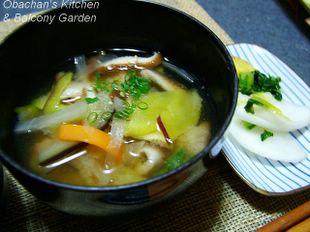 Categories: Japanese |
Posted by
obachan
at
11/22/2006 10:09:00 AM
0
comments
![]()
Labels: Rice dish
Friday, September 22, 2006
Asari Takikomi Gohan
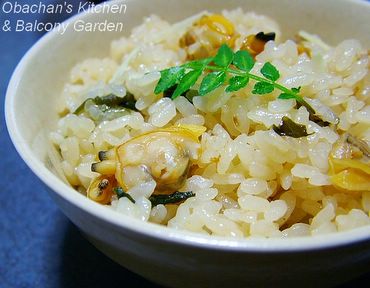 Asari no Takikomi Gohan (Japanese Pilaf with Short-necked Clams) When it starts getting cooler and more and more autumn fruits start occupying the shelves at local grocers and supermarkets, I feel this strong urge to make takikomi gohan (Japanese pilaf) with my donabe (clay pot). Today I went for asari (short-necked clam) takikomi gohan, which was actually part of the course meal at our kaiseki place last month. When it comes to takikomi gohan, there is one rule that I always follow: I never make takikomi gohan without sake and mirin. Well, actually I might go for it if I had either one of them, but if I run out of both, I never make takikomi gohan.  For me these two ingredients make a lot of difference. As I probably wrote somewhere before (did I? I don’t remember exactly…) alcohol and amino acids they contain contribute in adding extra flavors as well as helping the food absorb flavors of the seasonings. For me these two ingredients make a lot of difference. As I probably wrote somewhere before (did I? I don’t remember exactly…) alcohol and amino acids they contain contribute in adding extra flavors as well as helping the food absorb flavors of the seasonings.And what’s more, mirin prevents food from being mushy while being cooked. It is said that it prevents certain binding substance between cells from melting when heated. So, for me, mirin is a crucial ingredient for this kind of dish because I cannot stand mushy rice, especially mushy takikomi gohan. (I heard that professional Japanese chefs often add a little mirin or salad oil when they cook rice for making donburi, because mushy rice is a big no-no for that type of dish.)  For this takikomi gohan, I used asari and wakame kelp. The topping -- sansho (Japanese pepper) leaves and minced ginger -- were supposed to reduce the fishiness and bring out the flavor of asari clams. I made nameko mushroom miso soup to accompany this rice dish. For this takikomi gohan, I used asari and wakame kelp. The topping -- sansho (Japanese pepper) leaves and minced ginger -- were supposed to reduce the fishiness and bring out the flavor of asari clams. I made nameko mushroom miso soup to accompany this rice dish.Oh, there’s one more thing: To make this takikomi gohan, I used the new rice harvested just recently. Actually, here in Kochi, it’s not a big deal to be able to eat new rice in September, because it is usually available in late August. Here people plant rice earlier so that they can harvest it before the typhoon season comes. One thing you have to be careful about cooking new rice is using a little less amount of water. New rice contains more water than older rice, so adjustment is necessary. Well, I’m talking about the sticky short-grain rice we eat here in Japan, but I wonder if it is the same with long-grain rice. Categories: Japanese |
Posted by
obachan
at
9/22/2006 10:22:00 AM
10
comments
![]()
Labels: Claypot dish, Rice dish
Tuesday, August 29, 2006
Gumbo in the South of Shikoku Island, Japan
 Shrimp and Sausage Gumbo over Japanese Short-grain Rice I usually rely on this recipe for making the roux (though I use canola instead of peanut oil), but improvise a lot with the rest. Today I ventured to go for shrimp and a little expensive spicy sausage. 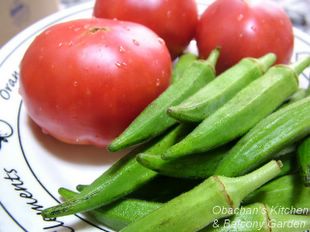 The sausage was worth the price and made this dish way better than my last attempt with chicken and cheaper sausage. :D The sausage was worth the price and made this dish way better than my last attempt with chicken and cheaper sausage. :DI froze about half of the gumbo base today, so next time I can experiment with different ingredients but don't have to make the whole thing from scratch. Maybe crab meat for the next time… and long grain rice. Categories: Western-inspired |
Posted by
obachan
at
8/29/2006 05:18:00 PM
11
comments
![]()
Labels: Rice dish
Thursday, July 13, 2006
My First and Not-very-successful Attempt
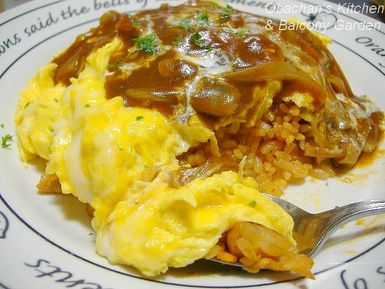 Omuraisu with Demi Glace Sauce While good many people dislike or even hate omuraisu, there seem to be others (not only Japanese) who love this Japanese invention and crave for it every now and then. I have received several comments/emails requesting omuraisu recipe, so now I am working on it... slowly. This is just the beginning phase: trying out recipes that I found on the net so that I can develop my own recipe based on them. I guess my own recipe of “rice rolled in omelet” type of omuraisu is almost ready. But before posting it, I had to try this type: cut-and-opened omelet over rice with demi glace sauce. Yes, I wanted to see which is easier to make and which I would like better. Unfortunately, my attempt today wasn’t very successful, because I overcooked the eggs. I left the omelet in the frying pan a little too long, trying to take a photo there. Also I waited a bit too long after I placed the omelet on top of the rice, taking a shot there again, before cutting it to open. And what made me mad was that those photos were all blurred! But there was something else which was not completely my fault; the strong taste of the demi glace sauce (I used canned HEINZ demi glace sauce) completely killed the flavor of the fried rice. Those who do not care for ketchup-flavored rice may like it that way, but for me, it's no good. To me, what's important for omuraisu is the harmony of the taste of ketchup-seasoned fried rice, sweet but not too sweet omelet, and the ketchup topping. With this type of omuraisu, I can almost always enjoy the harmony. But with the one I made today, I didn’t see any reason why the rice underneath the omelet needed to be seasoned with ketchup at all. That’s probably why many people use buttered rice for this type of omelet. I’ll try this again with buttered rice next time, and if I liked it, I’ll post the recipe. ;) Categories: Japanese |
Posted by
obachan
at
7/13/2006 12:06:00 AM
11
comments
![]()
Labels: Rice dish
Monday, February 13, 2006
Friendly Sushi Place
Fish fish’s recent sushi post had triggered my sushi craving, and this was the place I went last Saturday. Yeah, I can’t afford expensive sushi served at a real sushi restaurant, but I can go for a more action-oriented sushi once in a while --- the ones that come and go on the belt-conveyor. ;)  Broiled mayonnaise-prawn sushi? 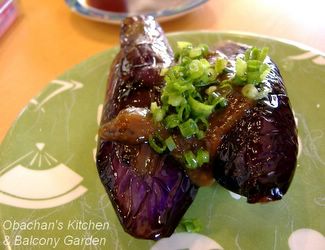 Fried eggplant with miso glaze sushi? 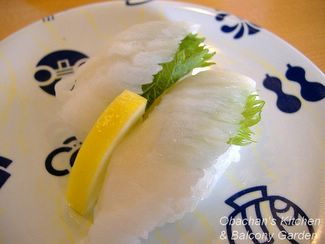 Hirame (left-eyed flounder) sushi 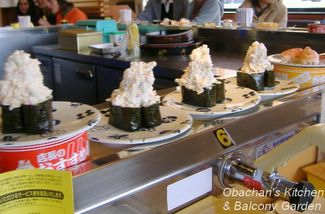 Jumbo hokki-gai gunkan I wish I had more money that day. BTW, in a kaiten-zushi shop, sometimes the conveyor makes me feel a little dizzy. Does this happen to you, too? |
Posted by
obachan
at
2/13/2006 02:17:00 PM
10
comments
![]()
Labels: Rice dish
Thursday, February 02, 2006
Kakiage Don
 Kakiage Don I work at an izakaya pub in Japan, and kakiage don is something they often make for staff’s meal there. When this dish is served for supper, waiters/waitresses figure out that the kitchen staff is really busy that night and there aren’t much leftover ingredients in the kitchen. Kakiage Don (Shredded Vegetable/Seafood Tempura on a Bowl of Rice) Ingredients - 2 to 3 servings - The vegetable/seafood ingredients can be substituted with your favorites.  (20 to 30 g for each) (20 to 30 g for each)- Carrot - Onion - Sweet potato - Mitsuba (Japanese wild parsley) - Shrimp - Kobashira (eye of scallop) Cooked short grain rice for 2 to 3 servings Vegetable oil for deep-frying Batter 55 g flour (cake flour preferred) 2 tsp corn or potato starch 1 egg yolk A pinch salt 100 mL ice water (1 tsp sake … optional) Tsuyu (Sauce) 160 mL dashi stock 40 mL soy sauce 40 mL mirin 40 mL sake 1+1/2 tsp sugar Instruction 1. Heat all tsuyu (sauce) ingredients in a sauce pan and bring to boil. Remove from heat. Set aside. 2. Shred vegetables. Cut seafood in small chunks.  3. In a bowl, mix egg yolk and ice water. (Do not get ice in the egg-water mixture. Add sake, if desired.) In another bowl, mix flour, corn or potato starch and salt and add to the mixture. Stir lightly by running chopsticks or a fork through the batter in a “cutting” manner so that it does not develop gluten in the flour. The batter can be lumpy and should be slightly runnier than regular tempura batter. 3. In a bowl, mix egg yolk and ice water. (Do not get ice in the egg-water mixture. Add sake, if desired.) In another bowl, mix flour, corn or potato starch and salt and add to the mixture. Stir lightly by running chopsticks or a fork through the batter in a “cutting” manner so that it does not develop gluten in the flour. The batter can be lumpy and should be slightly runnier than regular tempura batter. 4. Add shredded vegetables and seafood chunks to the bowl that was used for mixing dry ingredients. Sprinkle with a little amount of flour and toss to coat the vegetables and seafood. 4. Add shredded vegetables and seafood chunks to the bowl that was used for mixing dry ingredients. Sprinkle with a little amount of flour and toss to coat the vegetables and seafood. 5. Pour the batter over the ingredients and mix. 5. Pour the batter over the ingredients and mix. 6. Heat vegetable oil to apx. 180 C. Take a scoop of the ingredients on a turner and let the excess batter drip off. 6. Heat vegetable oil to apx. 180 C. Take a scoop of the ingredients on a turner and let the excess batter drip off.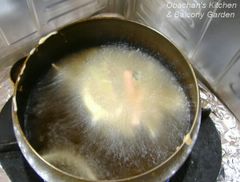 Slip the ingredients into oil, pushing gently with chopsticks or a fork. Deep-fry until both sides are golden brown. Slip the ingredients into oil, pushing gently with chopsticks or a fork. Deep-fry until both sides are golden brown.Drain on paper towels.  7. Heat the sauce again. Pour sauce (apx. 60 to 70 mL per serving) over warm rice in a big rice bowl (donburi). Place a kakiage on the turner and dip it very briefly in the remaining sauce in the saucepan, then transfer onto the rice. Serve warm. Read More for Serving Suggestions and Tips  Serving suggestions: Pickles, soup (especially miso soup) and hot green tea would be nice accompaniment to refresh the tongue. If you like the kakiage crispier, just place it on top of rice without dipping in the sauce and pour sauce over it. * Tips: Now, these are various tips for crunchy tempura batter that I’ve found on Japanese websites. Maybe you’ve heard of some of these, but there might be something totally new to you. Choose what you like. ;) To make crunchy tempura batter: 1. Use ice water to make batter and keep ingredients refrigerated until use. 2. Use egg yolk, instead of whole egg. 3. Add a little corn/potato starch to flour. 4. Add a little salt to flour. 5. Add a little baking powder to flour. 6. Add a little vinegar to batter. 7. Add a little beer or other kind of alcohol to batter. 8. Use mayonnaise instead of egg. 9. Use unsweetened soda water instead of ice water. 10. Use rice flour instead of flour. 11. Make batter right before you start deep-frying. Do not make it way beforehand. I have tried 1 to 4 and 11, and they seem to work for me, but you may not get the same result because the crunchiness of tempura also depends on other factors such as the kind/temperature of the oil you use, how you drain tempura, etc. I use vegetable oil, sometimes canola, and at our izakaya, we use the mixture of shirashime oil (refined oil) and lard.  |
Posted by
obachan
at
2/02/2006 08:45:00 PM
12
comments
![]()
Labels: Deep-fried dish, Rice dish


























